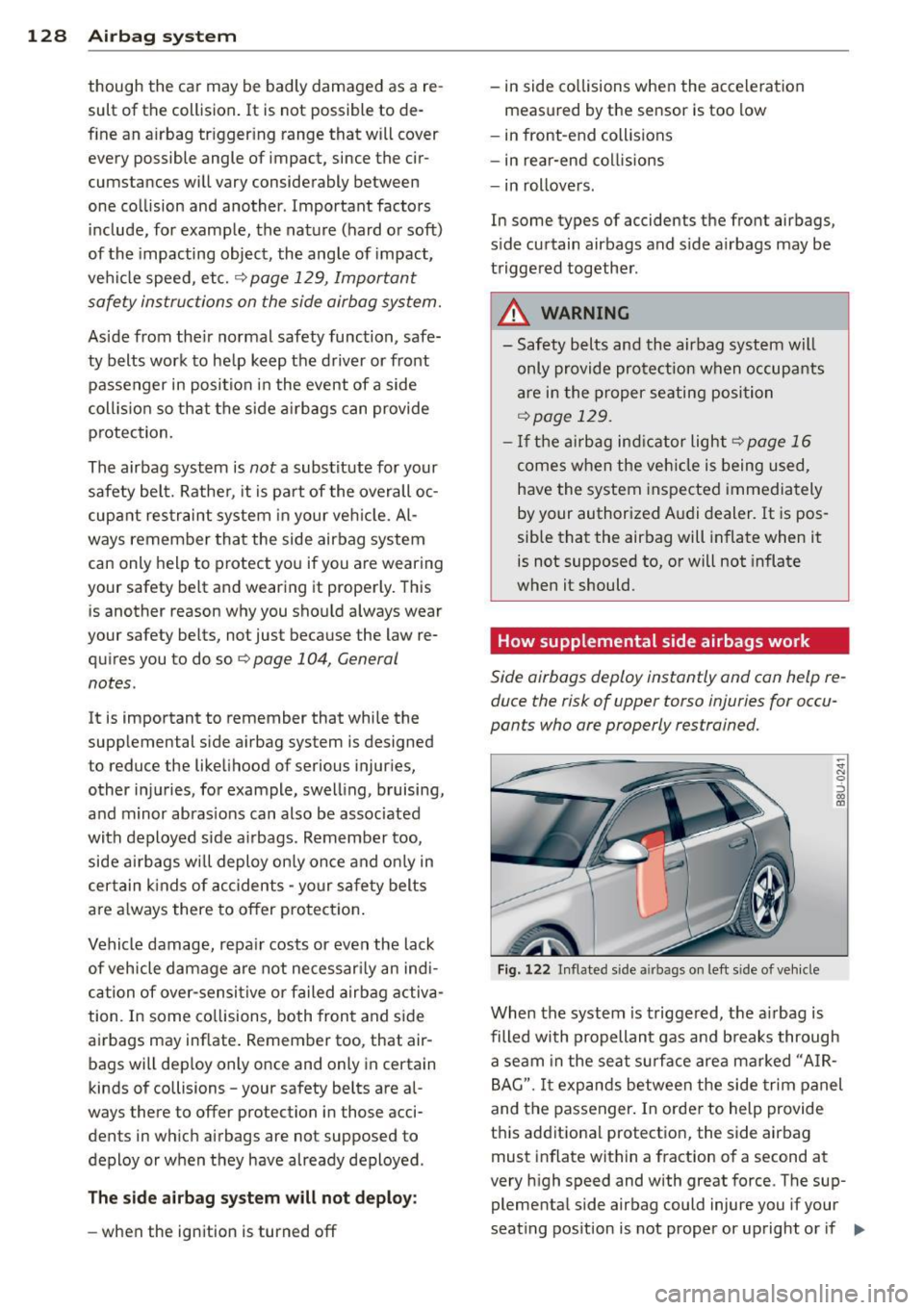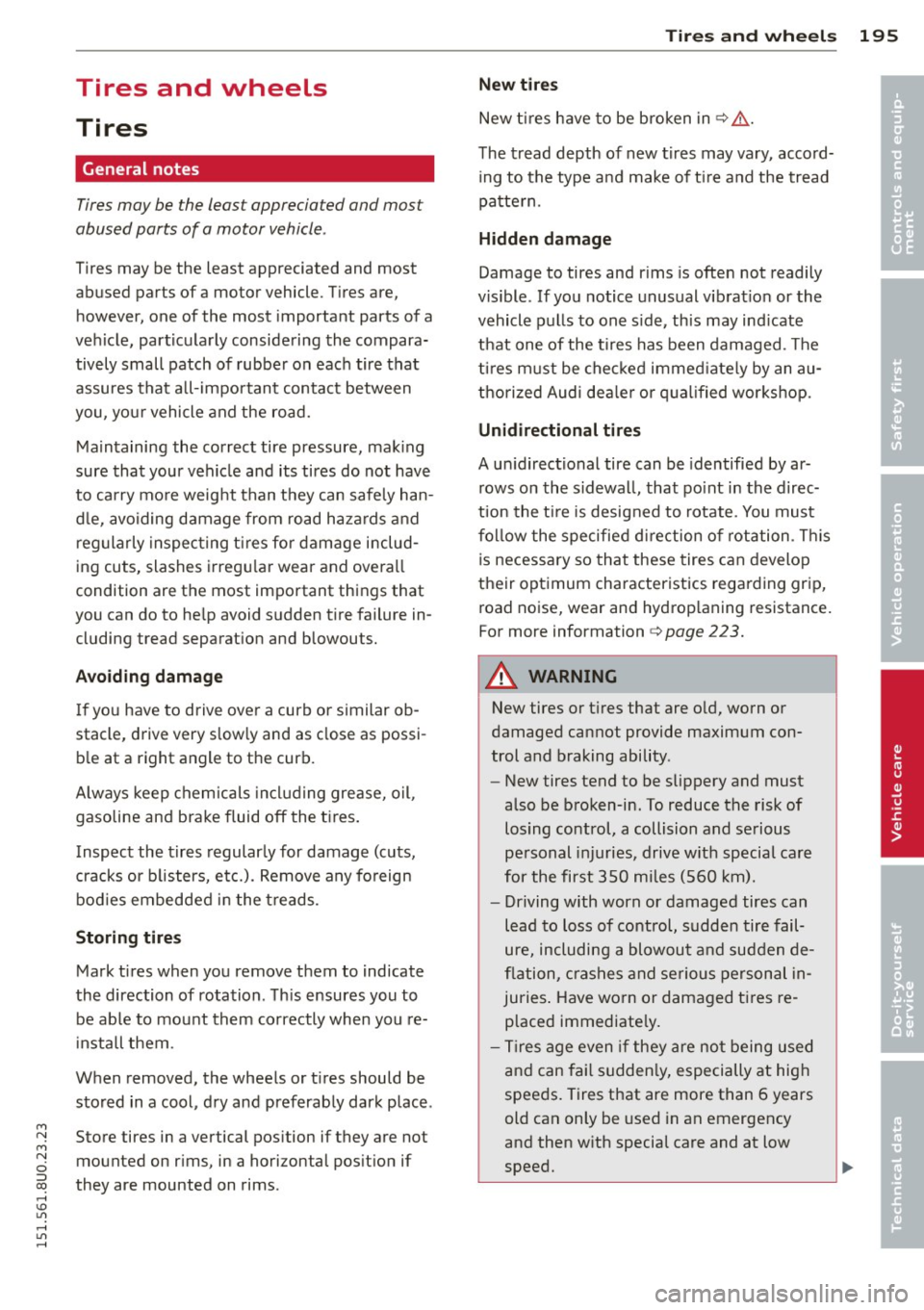gas type AUDI Q3 2015 Owners Manual
[x] Cancel search | Manufacturer: AUDI, Model Year: 2015, Model line: Q3, Model: AUDI Q3 2015Pages: 258, PDF Size: 64.9 MB
Page 130 of 258

128 Airbag system
though the car may be badly damaged as a re
sult of the collision . It is not possible to de
f ine an a irbag tr igger ing range that will cover
every possible angle of impact, since the cir
cumstances will vary considerably between
one collision and another . Important facto rs
include, for example, the nature (hard or soft)
of the impacting object, the ang le of impact,
vehi cle speed, etc. ¢
page 129, Important
safety instructions on the side airbag system.
As ide from the ir normal safety function, safe
ty belts work to he lp keep the driver or front
passenger in position in the event of a side
coll is ion so th at the side a irbags can provide
protection.
The airbag system is
not a substitute for your
safety be lt. Rather, it is pa rt of the overall oc
cupant restraint system in your ve hicle. Al
ways remember that the side airbag system
can only help to protect you if you are wearing
your safety belt and wearing it properly. This is another reason why you should a lways wear
your safety belts, not just because the law re
quires you to do so¢
page 104, General
notes .
It is important to remember that while the
supplemental s ide a irbag system is designed
to reduce the like lihood of serious injur ies,
other injuries, for example, swell ing, bruising,
and minor abras ions can also be associated
with deployed side a irbags . Remember too,
side ai rbags w ill deploy on ly once and o nly in
cer tain k inds of accidents -yo ur sa fe ty belts
a re a lways there to offer protect ion .
Vehicle damage, repair costs or even the lack
of veh icle damage are not necessar ily an indi
cation of over-sensi tive or failed a irbag activ a
tion. In some co llisions, both fron t and s ide
airbags may inflate. Remember too, that air bags will deploy only once and only in certain
kinds of collisions -your safety belts are al
ways there to offer protection in those acci
dents in which airbags are not supposed to
deploy or when they have already deployed .
The side airbag sy ste m will not depl oy :
- when the ignition is turned off - in side co
llisions when the accelera tion
meas ured by the sensor is too low
- in front -end collisions
- in rear -end collisions
- in rollove rs .
In some types of accidents the front airbags,
s ide curtain airbags and s ide a irbags may be
trigge red together .
_&. WARNING
-
-Safety b elts and th e airbag system w ill
only provide prote ction when occupa nts
are in the proper seating position
9 page 129.
- If th e ai rbag ind icator light ¢page 16
comes when the veh icle is being used,
have the system inspected immediately
by your authorized A udi dealer. It is pos
sible that the airbag will inflate when it
is not supposed to, or will not inflate
when it should.
How supplemental side airbags work
Side airbags deploy instantly and can help re
duce the risk of upper torso injuries for occu
pants who are properly restrained.
F ig. 122 In flated side a irbags o n left s ide of veh icle
~ 0 :::, 00 a,
When the system is triggered, t he a irbag is
filled with propellant gas and b reaks through
a seam in the seat su rface area ma rked "AIR
BAG".
It expands between the side trim panel
and the passenger . In order to help provide
t hi s additional protect ion, the side airbag
must inflate within a fraction of a second at
very h igh speed and with great force . The sup
plementa l side airbag could injure you if your
seat ing pos ition is not proper or upright or if ..,.
Page 178 of 258

176 Fuel suppl y and fillin g your fu el tank
Many gaso line grades are blended to perform
especially we ll for winter or summer driving.
During seasonal change-over, we suggest that
you fill up at busy gas stations where the sea sonal adjustment is more likely to be made in
time.
@ Note
- Methanol fuels which do not meet these
requirements may cause corrosion and
damage to plastic and rubber compo
nents in the fuel system.
- Do not use fuels that fail to meet the
spec ified criter ia in this chapter .
- If you are unable to determine whether
or not a particular fuel blend meets the
spec ificat ions, ask your service station o r
i ts fuel supplier .
- Do not use fuel for wh ich the contents
cannot be identified .
- Fuel system damage and performance
problems resulting from the use of fuels
different from those specified are not
the respons ibility of Audi and are not
covered under the New Ve hicle or the
Emission Control System Warranties.
- If you experience a loss of fue l economy
or driveabil ity and performance prob
l ems due to the use o f one of these fuel
blends, we recommend that you switch
to unblended fuel.
Gasoline additives
A major concern among many auto manufac
turers is carbon deposit build-up caused by
the type of gasoline you use .
A lthough gasoline grades diffe r from one
manufac turer to another, they have certa in
things in common. All gasoline grades contain
substances that can cause depos its to collect
on vital engine parts, such as fuel injectors
and intake valves . Although most gasoline
b rands include additives to keep eng ine and
fuel systems clean , they are not eq ua lly effec
tive. Audi recommends using
TOP TIER Detergent
Gasoline . For more information on TOP TIER
Detergent Gasoline, please go to the official
website (www.toptiergas .com) .
After an extended period o f using inadeq uate
fuels, built-up carbon deposits can rob your engine of peak performance.
(D Note
- Damage or malfunction due to poor fuel
quality is not covered by the Audi New
Vehicle Limited Warranty .
- Do not add afte rmarket fuel additive
produc ts to your f uel tank .
Fuel tank
Fuel filler neck
The fuel filler neck is located on the right rear
s ide panel behind the fuel filler flap.
If the power locking system should fail, you
can still open the flap manually -for detailed
instruct ions see o page 178.
You can find the fuel tank capacity of your ve
hicle in
o page 235 .
The label on the inside of the f uel fi ller flap
te lls you the correct fue l for your vehicle. For
more information about fue l specifications,
see
c:;, poge 175.
Your vehicle fue l tank has an on -board refuel
ing vapor recovery system . This feature helps
to prevent fuel vapors from escaping from the
tank and pollut ing the environment while you
refuel your vehicle. In order to fill the tank
properly while protecting the environment,
please follow this refueling procedure careful
ly.
.&_ WARNING
Under normal operating cond itions, never
carry addit ional fue l conta iners in your car .
Gas canisters and other conta iners used to
transport f uel can be dangero us. Such con-
tainers, fu ll or empty, may leak and could ..,.
Page 197 of 258

M N
M N
0 ::i co ,...., \!) 1.1'1 ,...., 1.1'1 ,....,
Tires and wheels
Tires
General notes
Tires may be the least appreciated and most
abused parts of a motor vehicle .
Tires may be the least appreciated and most
abused parts of a motor vehicle . Tires are,
however, one of the most important parts of a
vehicle, particularly considering the compara
tively small patch of rubber on eac h tire that
assures that a ll- important contact between
you, you r vehicle and the road.
Ma intaining the correct tire pressure, mak ing
sure that your vehicle and its tires do not have
to carry mo re weight than they can safely han
d le, avoiding damage from road hazards and
r eg ularly inspec ting t ires for damage i nclud
ing cuts, slashes irreg ular wear and ove ra ll
condition are the most important things that
you can do to he lp avoid sudden tire failure in
cluding tread separat ion and blowouts.
Avoiding damage If you have to d rive over a curb or similar ob
stacle, drive very slow ly and as close as possi
b le at a right angle to the curb.
A lways keep chemicals includ ing grease, o il ,
gasoline and brake fluid off the t ires .
I nspect the t ires regularly for damage (cuts,
cracks or b listers, etc.). Remove any fo reign
bod ies embedde d in the treads.
Storing tires Mark tires when you remove them to indicate
the direction of rotation . T his ensures you to
be ab le to mount them correctly when you re
i nstall them .
When removed, the whee ls or t ires should be
sto red in a cool, d ry and preferably dark place .
Store tires in a vertical pos ition if they are not
mounted on rims, in a horizontal pos it ion if
they are mounted on rims .
Tires an d wheel s 195
New tires
New tires h ave to be broken in ¢ & .
The tread depth of new t ires may vary, accord
ing to the type a nd make of t ire and the tread
pa tte rn.
Hidden damage
Damage to tires and rims is ofte n not readily
visible . If you notice unusual v ib rat io n or the
vehicle p ulls to one s ide, th is may ind icate
that one of the t ires has been damaged . T he
ti res m ust be chec ked immed iate ly by an au
t horized Audi dea le r or q ua lified wor kshop .
Unidirectional tires
A un idirectional tire can be identified by ar
rows on the sidewa ll, that po int in the direc
tion the t ire is designed to rotate. You mus t
f ol low the specified d irection o f rotation . T his
is necessary so that these tires can develop
their optimum characteristics regarding grip, road noise, wear and hydrop laning resistance.
For more information
¢page 223.
A WARNING
New tires or t ires that are o ld, worn or
damaged cannot provide maximum con
trol and braking ability .
-
-New tires tend to be slippery and must
also be b roken-in. To reduce the risk of
losing control , a collision and serious
pe rsonal injuries, drive w it h special care
for the first 350 miles (560 km).
- Driving with worn or damaged tires can
lead to loss of control, sudden tire fail
ure, including a blowout and sudden de
fl ation, c ras hes and se riou s personal in
juries . Have wo rn or damaged t ires re
placed immediate ly.
- Ti res age even if they are no t being used
an d can fai l sudden ly, especially at hig h
spee ds. Tires that are more than 6 years
old can only be used in an emergency
and then w ith special care and at low
speed.
•
•